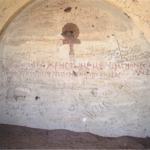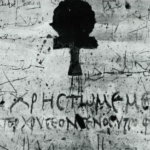| Artefact ID | 699 |
| TM ID | TM 38522 |
| Findspot (DEChriM ID) | 15 (al-Baǧawāt) | Class | Funerary element, Textual |
| Material | Plaster |
| Writing medium | Dipinto |
| Text content | Subliterary |
| Language | Greek |
| Description | I.Oasis p. 69 no. 12; SB XX 14858; IGChrEg 353; I.Métriques 173; SEG 53 1920: Funerary epigram dedicated to Ammonios. On the wall facing the entrance, painted in red, under a large crux ansata, two lines of a metric epigram written in a large hand mixing majuscule and minuscule elements (angular majuscule alpha with broken middle element at the end of the lines (see I.Oasis p. 69 no. 13) / round minuscule alpha; use of ligatures drawing on documentary habits), the letters of the second line being of smaller size. The epigram is dedicated to one Ammonios, "esteemed in Christ", with an invocation to "Father Christ, thou who hast shown a golden lineage". Mixing quotations from both classical (Hesiod) and Christian (Gregory of Nazianzen) authors, this erudite inscription is as famous as its content is debated, and the identity of the deceased Ammonios (without any patronym) remains unknown. On the other walls of the same chapel, see I.Oasis p. 69 no. 11 and I.Oasis p. 69 no. 13 |
| Selection criteria | Christian terms/formulas/concepts, Christian symbols/gestures/isopsephy, Archaeological context associated with Christian markers |
| Date from | 375 |
| Date to | 499 |
| Dating criteria | The suggested date is based on the archaeological context and parallels. The text has been diversely assigned from 4/5th c. (see SEG 8 792) up to 6th c. (Koenen 1968 and Bernand 1969: 626). Cipriano 2003: 278 suggests 5th c. |
| Absolute/relative date | Relative date |
| Archaeological context | Chapel no. 53, one of the oldest square domed type (type 4), opening south. The interior is coated with a layer of plaster; and a crux ansata is painted on every wall (see Fakhry 1951: 125). |
| Accession number | Al-Baǧawāt, in situ (Chapel no. 53 / Roquet, Ghica no. 28.03). |


 Json data
Json data





